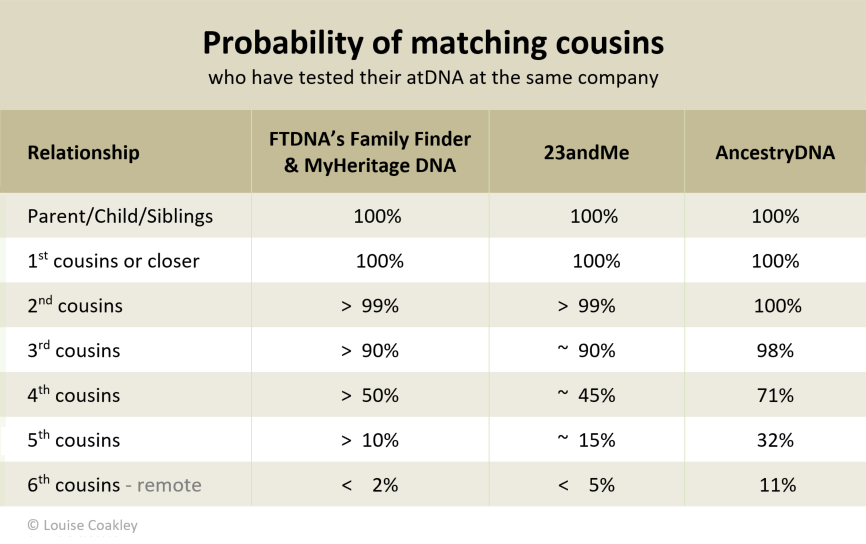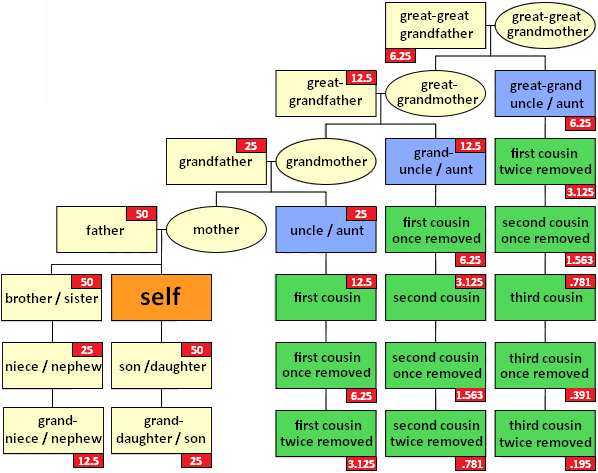Everyone inherits autosomal DNA from their parents: 50% from each parent, which contains a random mix of DNA segments from their parents, their parents, their parents, back for several more generations.
The wonderful feature of autosomal DNA is that it can be inherited from all lines of your pedigree, not just the direct paternal or maternal lines.
Anyone can test their autosomal DNA – any age, any gender – and it is quick and easy to do, via a cheek swab or saliva sample.
AncestryDNA, MyHeritage DNA, Family Finder from Family Tree DNA, 23andMe and Living DNA are all autosomal DNA tests.
Any one of your ancestors in the pedigree chart below could have passed some of their DNA onto you, and to other descendants as well, even quite distant cousins.
If both you and other descendants of the same ancestors test with the same company, and share a segment of DNA in common, you should show up in each other’s list of matches.

Consider that even if you only go back six generations – to your 4th great grandparents as in the chart above – depending on how many surviving children each couple had, you could potentially have tens of thousands of 5th cousins.
Not all of your distant cousins will be detected as matches to you, as although you will have both inherited some segments of DNA from the same ancestors, they may not be the same segments, so won’t overlap and be detected as a match.
The chart below shows the likelihood of detecting cousins who have tested at the same company:

Sources: Family Tree DNA and 23andMe and AncestryDNA.
Each parent can only pass down half of their autosomal DNA to each child, so each child will get a random mix of segments from their parents, and consequently a random mix from each grandparent.
The diagram below demonstrates how the DNA can be recombined at each successive generation.
Three children of the same parents can get quite different mixes of DNA from their grandparents, which means they will match relatives and cousins slightly differently.

For 3rd cousins and further back, some of your tested cousins will be detected as matches to some siblings, and not detected by other siblings. Testing siblings is a very good idea to get DNA matches with a wider selection of cousins. If you don’t match a 3rd cousin as expected, test one of your siblings or your cousin’s siblings, as they might match each other.
Your genetic genealogy project will progress rapidly once you test some known cousins and/or confirm new cousins, as being able to identify your most recent common ancestors helps you isolate those lines you share with other matches in common.
It is also highly recommended to test older generations, if possible, as their DNA will be less diluted than the younger generations. Testing their DNA can also help isolate your other matches to your shared branches. If you are young enough to still have grandparents, great aunts, great uncles, or cousins of your grandparents, you are very lucky and would be wise to test them while you still can (DNA tests for birthday presents are a great idea!).
Relationships are estimated based on the percentage of shared DNA, eg. 50% for a parent, child or sibling; 25% for a grandparent/grandchild, aunt/uncle, half-sibling, niece/nephew; 12.5% for a great-grandparent, 1st cousin, great aunt/uncle; 6.25% another generation removed, etc.
The International Society of Genetic Geneaogy (ISOGG) Wiki contains some useful charts for estimating autosomal DNA matches based on the percentage of DNA shared, or the measure/quality of the segment shared (in centiMorgans – cM).
The chart below shows the average amount of autosomal DNA inherited by all close relatives up to the third cousin level:

https://www.isogg.org/wiki/Autosomal_DNA_statistics (Chart: Dimario, Wikimedia Commons)
The following table, adapted from the same ISOGG link, estimates relationships based on the average amount of autosomal DNA shared:
Some of the testing companies provide their own relationship estimate charts, usually accessible from the match detail page or linked to the amount of DNA shared.
The easiest way to estimate the relationship or range of possible relationships for a specific amount of shared DNA is to use a relationship calculator.
The free relationship calculator at the DNA Painter website uses real/observed relationship data sourced from the Shared cM Project.
Simply enter the amount of DNA you share with a match (in cM or %), and the calculator shows possible relationships for that amount, and their likely probabilities. Scroll further down the results page and a pedigree chart highlights the possible relationships, and shows the improbable relationships faded out.
Autosomal DNA testing does not ‘find or identify’ relatives as such, but matches testers with other people who have also tested with the same company. It is purely a matching system – the more people that test, the more matches everyone gets, including with previously unknown cousins. It is a big puzzle… you are given the clues which are the genetic relatives, and you have to use your genealogical research skills to find the records and evidence to connect them.
Traditional ‘paternity testing’ tests two specific individuals and compares a very small number of unique markers to see if they matched each other, or if they can be ‘excluded’ as parent-child. If not, the process is repeated with two new candidates (if any are available), and often at a significant cost.
With genealogical DNA testing, approximately 700,000 markers are tested and compared with those of hundreds of thousands of other people in the database.
Testers are given a list of people who share DNA with them, with the closest predicted relatives at the top of their match list. It is impossible to know before testing if you will get any close matches. It all depends on which of their relatives have already tested.
If you or the person you are testing is an adoptee, donor conceived, a foundling, or has unknown parentage for whatever reason, it is recommended that you/they test with or transfer to all the major genealogy DNA testing companies, to get their DNA into all databases to have the best chance of matching with others (in case the person they want to match with has tested at a different company). At a minimum, start by testing at AncestryDNA, then based on those results do the free transfers or consider further tests.
Testers at any of the major companies can also upload a copy of their raw data (results) to a free site called GEDmatch.com, where they can be compared with others who have tested at other companies and also uploaded their results. GEDmatch is not a replacement for testing at all companies, as only a small proportion of testers from each company upload their results, but it is a useful site with a wide range of helpful tools.
Simply order an autosomal DNA kit online from AncestryDNA, MyHeritage DNA, Family Tree DNA or 23andMe.
Refer to Which DNA testing company should I use? for a comparison of the features and current prices of autosomal tests at the major genealogy DNA testing companies. For a closer look, read What is an AncestryDNA test? and What is a Family Finder test?
Your kit will arrive in the mail, is very simple to do, you post it back to the testing company in the pre-addressed mailer or satchel, and your results and matches will be released in your online account when they are ready (you will be notified by email).